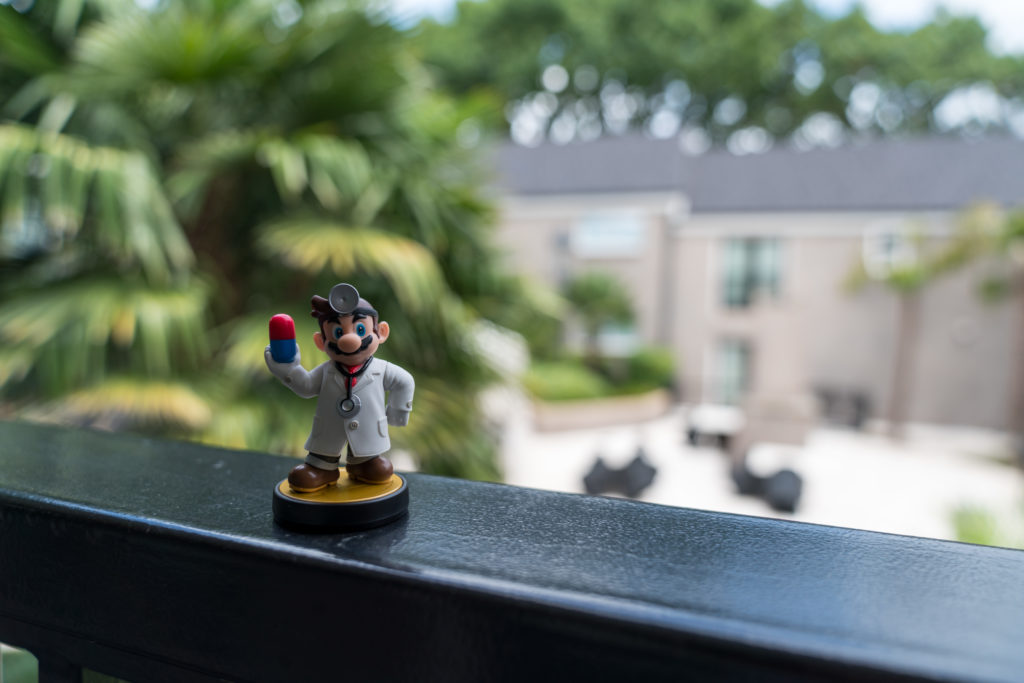I hope you enjoyed my first look at (and the macro pictures of) my new Sony 24-70 f2.8 G Master lens [Amazon affiliate link]. I wanted to show you some image samples from the lens so you can see the image quality for yourself.
I do not have a scientific process for taking image samples, at least not on purpose. Here’s what I did:
- Took a picture at 24mm of a plastic figurine against a varied background
- Took another picture of the same figurine against the same background but at 70mm
- Adjusted shadows, highlights, white point, and black point to taste in Lightroom, applied the same processing to both images (except for White Balance)
- For fun took a 9-picture “Brenizer method” bokeh panorama at 70mm, which I edited more artistically
Would sample images be better if they were epic landscape shots? Well obviously, but two things:
- I wanted to share full-size full-resolution images with you, which I hesitate doing with pretty landscape pictures, since I may sell them down the road
- Dallas is a bit rainy at the moment (and/or there have been epic sunsets for three nights in a row and I’ve managed to accidentally miss all of them)
So here are the images, with camera settings in the captions. If you’d like to zoom in and see the full 42-megapixel images you can right-click on them open them up in a new window.
If you’d like to see the bokeh panorama/Brenizer shot, here’s a link to the 107-megapixel panorama (caution for mobile users, it’s a 13MB file).
Initial Thoughts
So I’ve only had the lens for a week, during which I’ve used it to shoot an indoor volleyball tournament (on both the a7rII and a6300), yesterday’s What’s the Points video, and these sample images. Not exactly the most thorough test, I’ll admit.
With that said, I absolutely love this lens so far! Sure it’s enormous, but it’s a great bicep workout and the images are worth it.
- The falloff from in-focus to out-of-focus areas is smooth and I like the bokeh, even at 24mm.
- Autofocus is almost instantaneous and quiet.
- It feels balanced when you hold it, not front-heavy or oblong in any way.
- Surprisingly, the minimum focus distance (how close the lens can be to the subject with the subject in focus) is also nice. On my 70-200mm lens the minimum focus distance is 3.28 feet. On the Sony G Master at 70mm the minimum focus distance is 1.24 feet. That’s a massive 2 feet of difference! I realize that the Sony-Zeiss 24-70 f4 lens has a minimum focus distance of 1.32 feet, which isn’t much different, but for my equipment it’s a massive change. It’s also closer than my 55mm prime lens, which has a 1.64 feet minimum focus distance.
That said, the lens isn’t quite perfect. If you look at the 70mm example above, you’ll notice some blue fringing along the left sleeve of the figurine. It would be tough for any lens to deal with a transition not only from white to green but from in-focus to out-of-focus along that sleeve. As an area goes out of focus it tends to get a bit darker in color, in other words the color goes from white to grey. I think that’s why the sleeve ends up blue, it’s simply a color cast on a small section of the image going from white to dark grey to green. Overall not a massive issue but it’s something the pixel peepers will definitely notice.
Now, the Big Question
Let’s just go for it. The minor reasons I purchased this lens were needing the focal length range in my bag and because of my never-ending search for more sharpness. The major reason I purchased this lens was to replace 2-3 of my other lenses in my travel bag. The jury is still out but so far it looks like it will! The quality of the images taken with the Sony 24-70 G Master lens is on par or better than my 16-35mm, 55mm, and 70-200mm lenses. It is optically superb, feels like it’s built to last, and, most of all, versatile. If you’re in the market, definitely give this lens a look.



